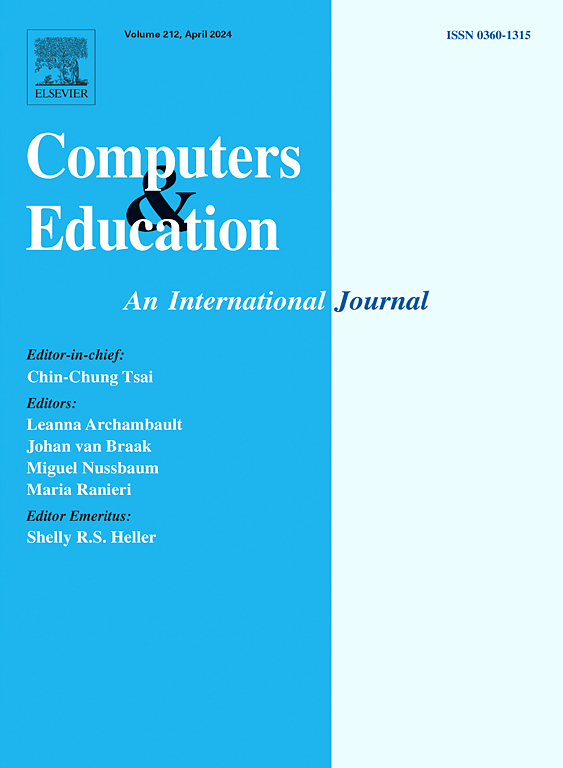沉浸式虚拟现实中的交互性和信号:对英语学习体验和结果的影响
IF 10.5
1区 教育学
Q1 COMPUTER SCIENCE, INTERDISCIPLINARY APPLICATIONS
引用次数: 0
摘要
沉浸式虚拟现实(IVR)因其高水平的沉浸性、交互性和引人入胜的学习体验而被用于教育领域,特别是在外语习得等情境学习场景中。虽然IVR在情境学习中得到了广泛的应用,但其有效性,特别是在通过互动和信号进行的第二语言学习中,仍未得到充分的探索。根据多媒体学习的认知理论(CTML)和沉浸式学习的认知-情感模型(CAMIL),本研究探讨了不同的信号类型(传统与反信号)和互动水平如何影响学习者在IVR环境中的有效性。为了探究二者的相互关系,我们进行了一项混合因素实验,其中两个因素均为自变量,因变量包括学习成果、认知负荷和内在动机等。结果表明,中等互动性产生最有利的学习结果,其次是高互动性,低互动性在所有测量中表现最差。所提出的方法(反信号)已被证明在减轻与增加的交互性相关的负面影响方面是有效的。使用Anti-Signaling,高交互性可以获得与中等交互性相似的学习结果。然而,在中低交互水平的信号类型之间没有观察到显著差异。这些发现指出了互动性和信号之间的相互作用,其中信号的好处随着互动性的增加而变得更加明显。此外,应用Anti-Signaling时未观察到明显的负面影响,表明它是一种无害的策略。我们的研究结果为不同交互性的影响提供了有价值的见解,并强调了反信号在IVR学习中的使用,特别是在学习效率和用户体验方面。本文章由计算机程序翻译,如有差异,请以英文原文为准。
Interactivity and signaling in Immersive Virtual Reality: Effects on EFL learning experiences and outcomes
Immersive Virtual Reality (IVR) is used in education due to its high level of immersion, interactivity, and engaging learning experience, particularly in situated learning scenarios such as foreign language acquisition. While IVR has been widely used in situated learning, its effectiveness, particularly in second language learning through interactivity and signaling, remains underexplored. According to the Cognitive Theory of Multimedia Learning (CTML) and the Cognitive-Affective Model of Immersive Learning (CAMIL), this study investigates how different signaling types (Traditional vs. Anti-Signaling) and levels of interactivity affect learners’ effectiveness in IVR environments. To explore their interrelationship, we conducted a mixed-factor experiment in which both factors served as independent variables, and the dependent variables included learning outcomes, cognitive load, and intrinsic motivation, among others. The results indicate that medium interactivity yields the most favorable learning outcomes, followed by high interactivity, with low interactivity performing worst across all measures. The proposed approach (Anti-Signaling) has been shown to be effective in mitigating the negative effects associated with increased interactivity. With Anti-Signaling, high interactivity can achieve similar learning outcomes to medium interactivity. However, no significant differences were observed between signaling types at medium or low levels of interactivity. These findings point to an interaction between interactivity and signaling, in which the benefits of signaling become more pronounced as interactivity increases. Besides, no significant negative effects were observed when applying Anti-Signaling, suggesting that it serves as a harmless strategy. Our findings offer valuable insights into the effects of varying interactivity and highlight the use of anti-signals in IVR learning, particularly in relation to learning efficiency and user experience.
求助全文
通过发布文献求助,成功后即可免费获取论文全文。
去求助
来源期刊

Computers & Education
工程技术-计算机:跨学科应用
CiteScore
27.10
自引率
5.80%
发文量
204
审稿时长
42 days
期刊介绍:
Computers & Education seeks to advance understanding of how digital technology can improve education by publishing high-quality research that expands both theory and practice. The journal welcomes research papers exploring the pedagogical applications of digital technology, with a focus broad enough to appeal to the wider education community.
 求助内容:
求助内容: 应助结果提醒方式:
应助结果提醒方式:


